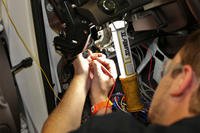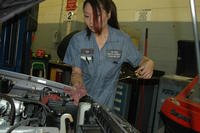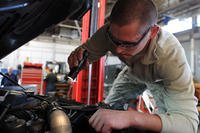Snow is a fickle monster. It can form shelters and keep you warm, or it can suck the life right out of you and turn you into a meal for the bears. It’s dangerous for vehicles, too.
Anyone who’s driven in the snow knows that tires have their limits. No tire -- summer compound, winter compound, all-terrain tread or studded -- can conquer winter weather every time. Check out the always entertaining California Highway Patrol Truckee Instagram account if you don’t believe me.
Waiting for a storm to blow over and plows to clear the highway isn’t an option for the U.S. military. One way to turn a blizzard into a battlefield advantage is to fire up the Army’s Cold-Weather All-Terrain Vehicle (CATV).
Pop the Hood on the CATV

Infantry units will always rely on boots to close with and destroy the enemy, but they also use modern fighting vehicles such as the Infantry Squad Vehicle and, eventually, killer robots. That is, unless you’re operating in a climate so cold and snowy that even those vehicles can’t keep up with skis and snowshoes.
Enter a cold-weather combat advantage that BAE Systems Hägglunds calls the BVs10 Beowulf and the Army calls the CATV. The mashup of Amphibious Assault Vehicle and ski resort groomer is an updated version of the BV206 Small Unit Support Vehicle (SUSV) that’s currently in service with the U.S. armed forces and several foreign militaries.
According to the vehicle’s spec sheet, this new machine boasts a 6.7-liter Cummins straight-six diesel paired with a six-speed Allison transmission (be still, my beating heart) that can haul 14 soldiers and their gear at a top speed of 43 mph on land and 2.5 mph in water -- all at temperatures as low as 50 degrees below zero. In standard form, the CATV has a range of 250 miles, but it’s possible to extend that to 620 miles with modifications.
“The small unit support vehicles were great in their day, but have needed replacing for the past two decades,” Maj. Gen. Brian S. Eifler, the commanding general of the 11th Airborne Division and deputy commander of the U.S. Alaskan Command at Joint Base Elmendorf-Richardson, Alaska, said of the CATV. “These new vehicles will provide our Arctic Angels with capable, reliable mobility and increase their survivability in the harshest conditions Alaska and the Arctic has to offer.”

The BVs10 prototypes must have performed well when the Army tested them between August 2021 and January 2022, because the Pentagon responded with a $278 million contract for 110 vehicles. The goal is to make America’s arctic warfighters -- particularly active-duty Army and Army National Guard units in Alaska -- more effective.
When BAE inked the deal in 2022, company officials announced, “Beowulf can traverse snow, ice, rock, sand, mud, and swamp conditions, and can operate in steep mountain environments. Its amphibious feature also allows it to swim in flooded areas or coastal waters.”

They weren’t bluffing. Army leadership was so impressed with the original purchase that, according to BAE, it came back for another $48 million order in 2022 and a cool $20 million worth of CATVs in 2025.
I can’t blame them; the CATV seems like an incredible asset. Not only can it shelter service members from deadly arctic storms (but there’s always room for one more) and traverse any terrain in its path, it’ll fit in a C-130 and hang from a CH-47.
This Isn’t Sweden’s First Rodeo

As anyone who’s gotten the so-called privilege of using cutting-edge military tech can tell you, sometimes the new hotness is actually hot garbage. Fortunately for America’s northernmost warfighters, the CATV is an evolution rather than an all-new design. In fact, it stands on a 50-year history of unflinching cold-weather performance.
In addition to building on the U.S. military’s existing SUSV, the new vehicle takes notes from overseas, where Hägglunds tracked personnel carriers are standard fare. European militaries have been using the CATV’s predecessors to stay on the move through long arctic winters since the great eastern front tank battles of World War II.
A trip down memory lane with the Hägglunds company history (brush up on your Swedish) will reveal tracked military vehicles dating back to as early as 1959.

According to reporting from European Security & Defence, 25 countries still used the BV206, which was originally launched in 1980, as recently as 2023. Given the ongoing hostilities in Ukraine, being able to quickly move troops across frozen European landscapes seems like a good idea.
Better yet, BAE reports that the unarmored U.S. variant shares 80% parts compatibility with European armored variants. That means spinning up support for the vehicle should take very little time and little cost (well, in defense budget terms, anyway).
Speaking of armor, the U.S. Army Acquisition Support Center reported in 2023 that the Army was pursuing an updated version of the CATV with armor and weapons. Think of that as the sleigh Santa uses to visit all the kids on his naughty list.
You Can (Kind of) Own a CATV

So the U.S. Army is getting the CATV and our European counterparts have their own versions. But what about you and me?
It’s possible to buy all kinds of surplus military vehicles (and that can be a lot of fun), but the CATV is an interesting case of civilian technology trickling into the military realm, rather than the other way around. That means there are lots of older examples that you can pick up without dealing with government auction sites and defense industry parts suppliers.
Tracked Outdoors, based in Casper, Wyoming, restores and customizes tracked vehicles for private buyers and government agencies. Want an old Hägglunds BV206 to build a CATV of your own? Go right ahead. Looking for the ultimate backcountry ski vacation? They restore snow cats, too.
According to Tracked Outdoors, a restored BV206 weighs 9,500 pounds and can carry another 4,400 pounds of people and cargo, but it only exerts two pounds per square inch of ground-bearing pressure. That means it practically floats across the surface of the snow and leaves minimal impact on bare ground. How eco-friendly! At the same time, it can carry up to 17 people at a sustained 34 mph. Imagine the camping trips you could have with that kind of RV.
Pricing is hard to find when so much custom work is involved, but there’s a more bare-bones “rancher special” for sale on the Tracked Outdoors website for $18,000. They’ll also help you out with service and a very extensive parts catalog for all you home mechanics.
What Does the Future Hold for the CATV?

You may not have room in your budget for a go-anywhere arctic crawler, but the U.S. Army sure does. When you consider climate change making the Arctic circle more passable, tensions with Russia and sudden talk of Greenland ducking under the U.S. military umbrella, having a vehicle that’s tougher than winter itself sounds like a good investment.
Army leadership at the Pentagon is clearly sold on the idea. It bought the CATV, ordered more and started the process of adding armor and weapons systems. Will the CATV become a lynchpin in North America’s defense? Will the Marine Corps get on board? We’ll have to wait and see. At least the CATV is giving us a warm place to sit in the meantime.
Want to Know More About the Military?
Be sure to get the latest news about the U.S. military, as well as critical info about how to join and all the benefits of service. Subscribe to Military.com and receive customized updates delivered straight to your inbox.











